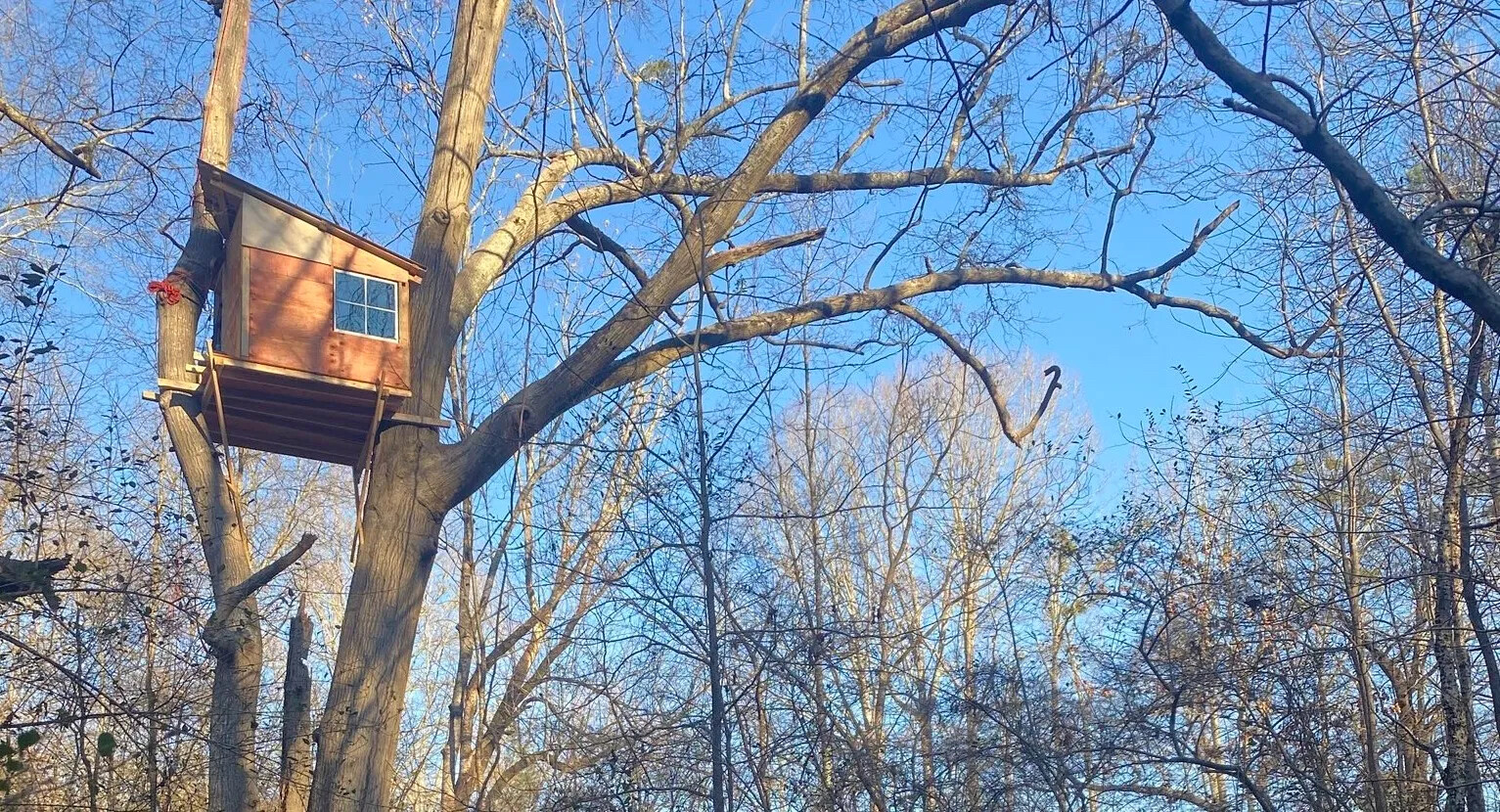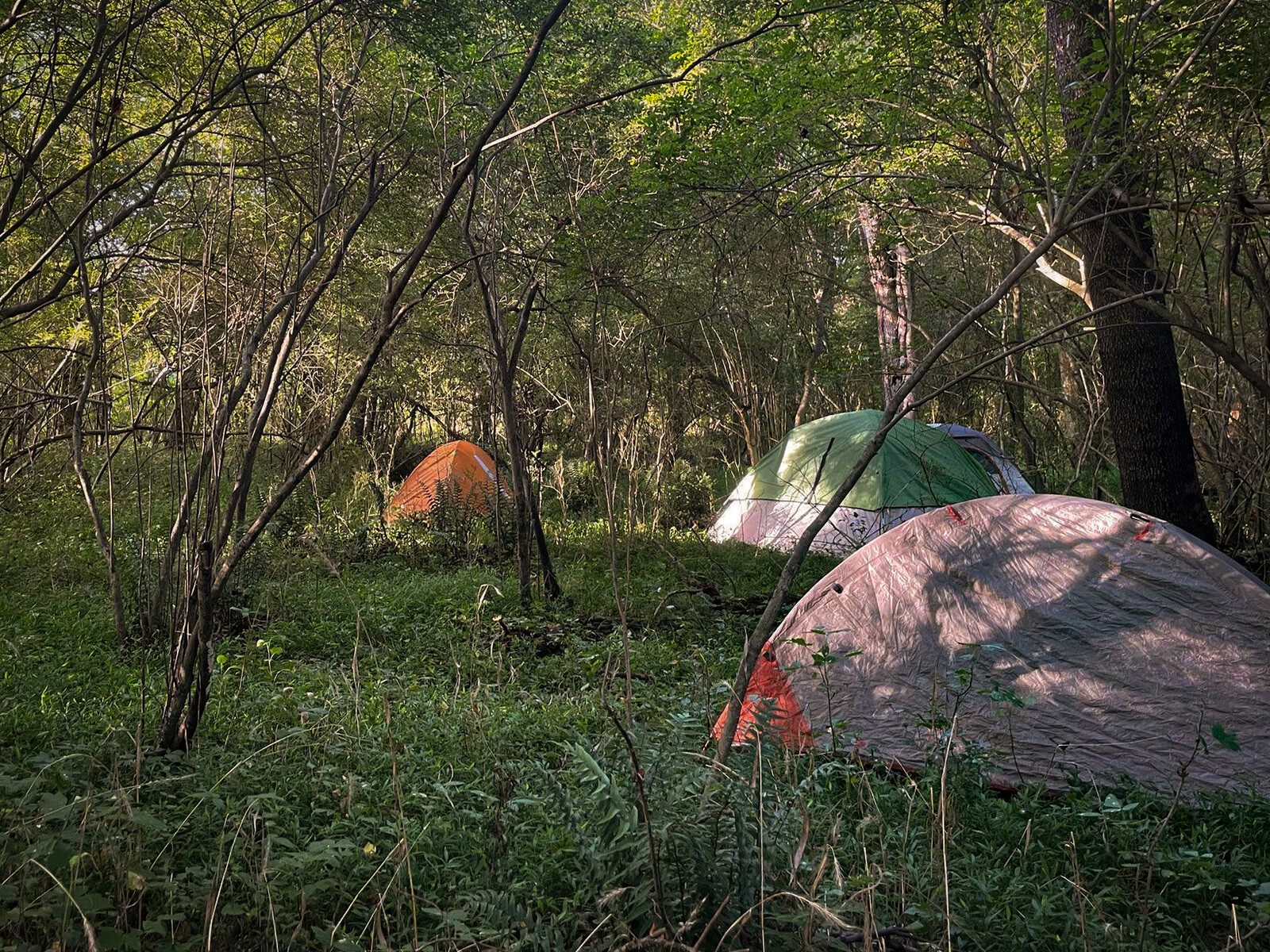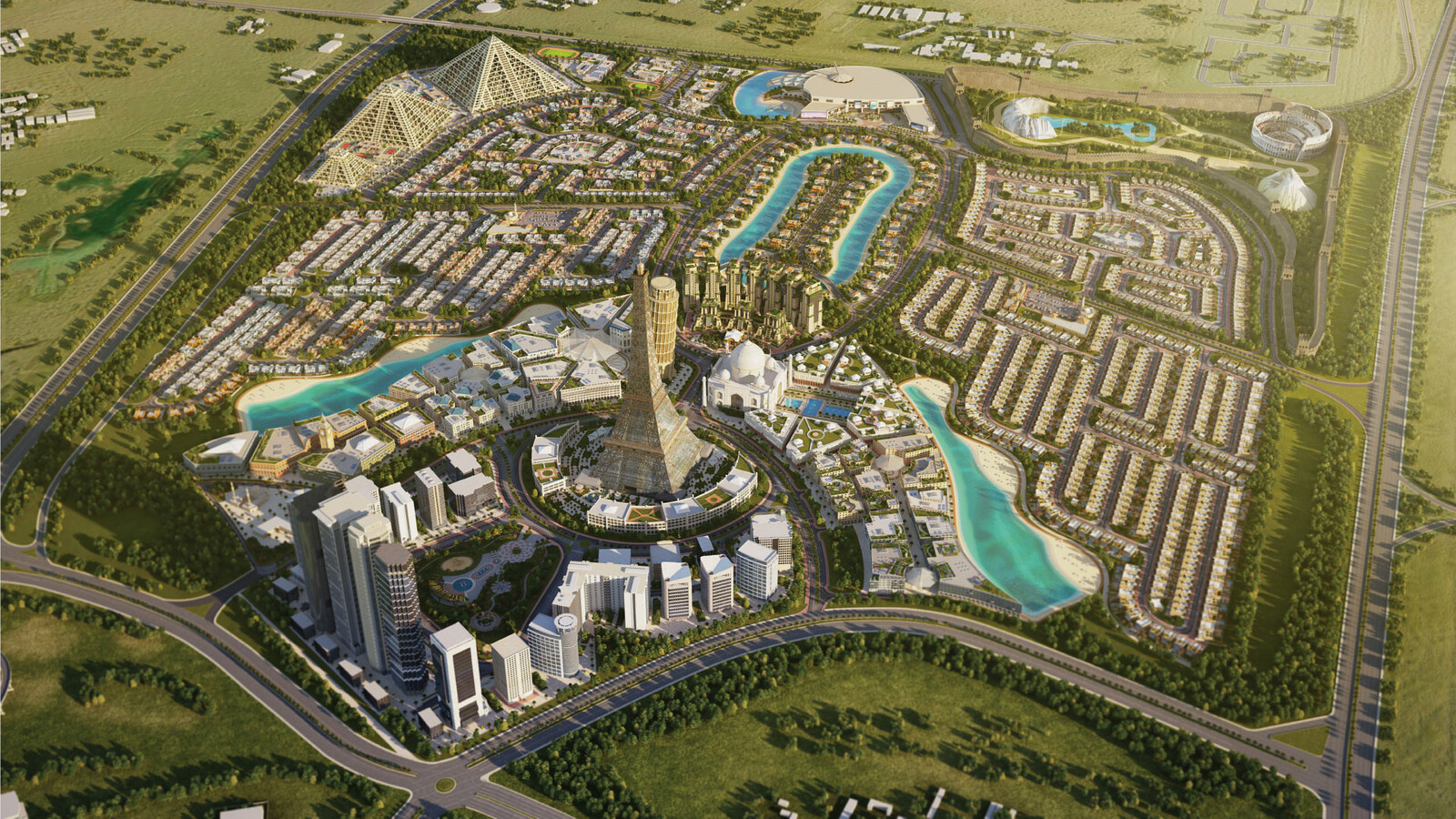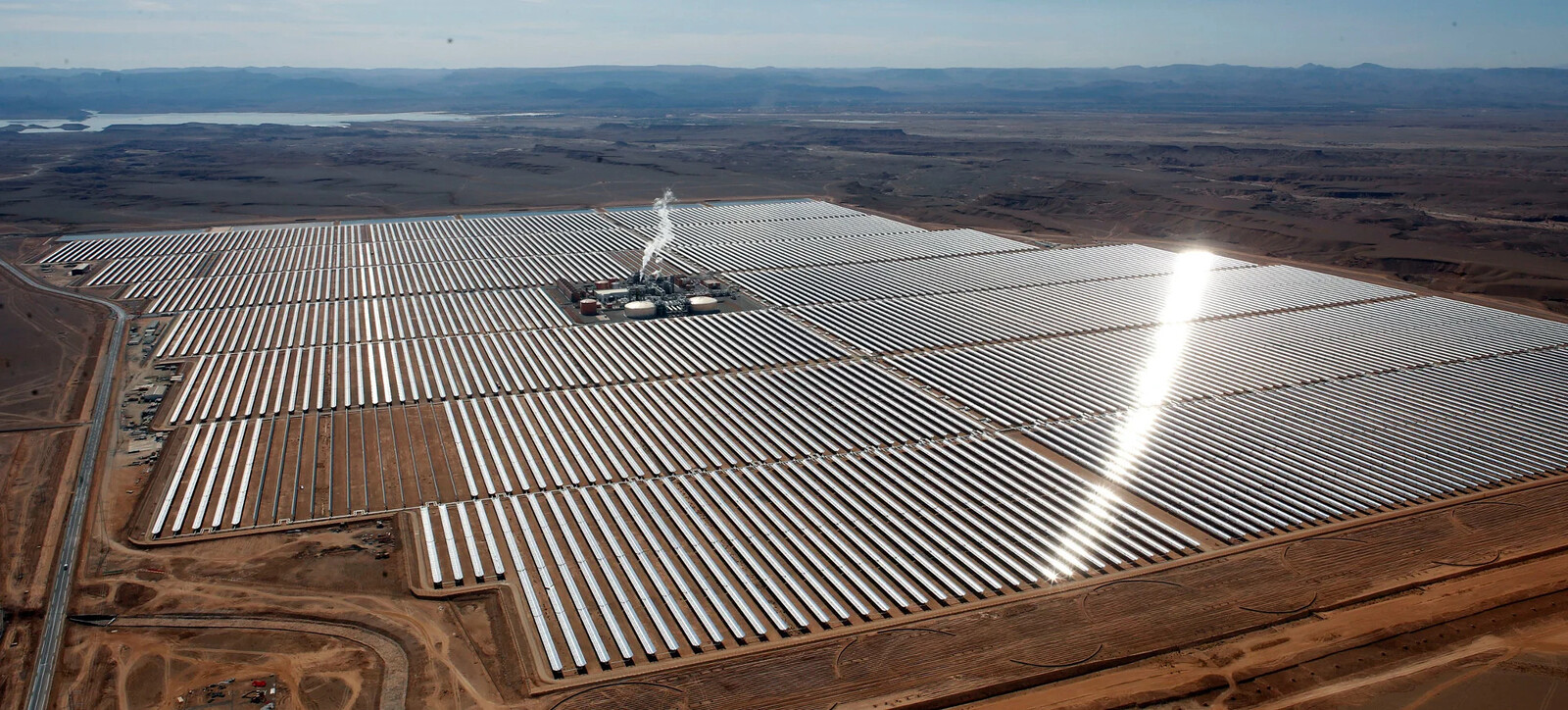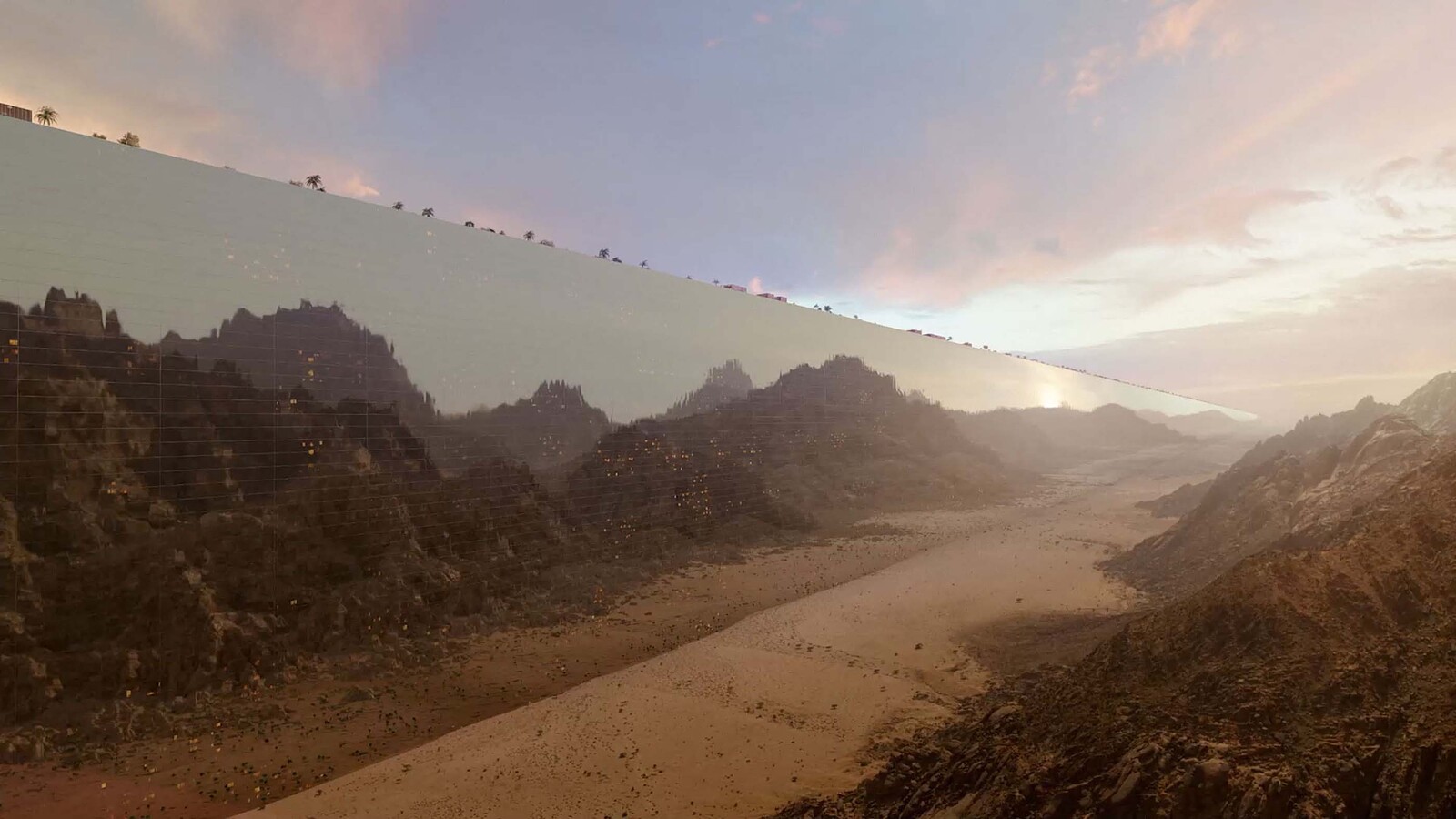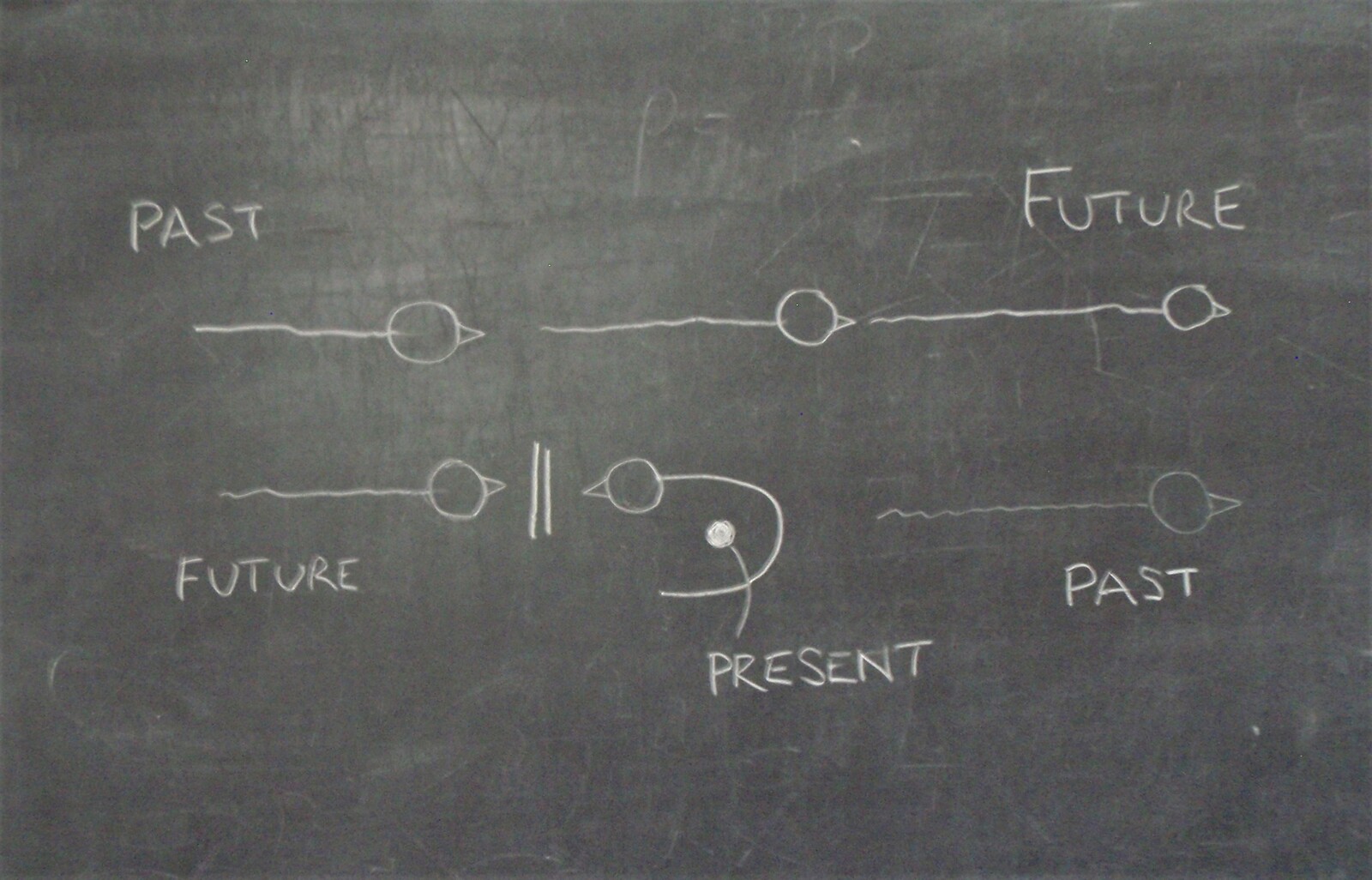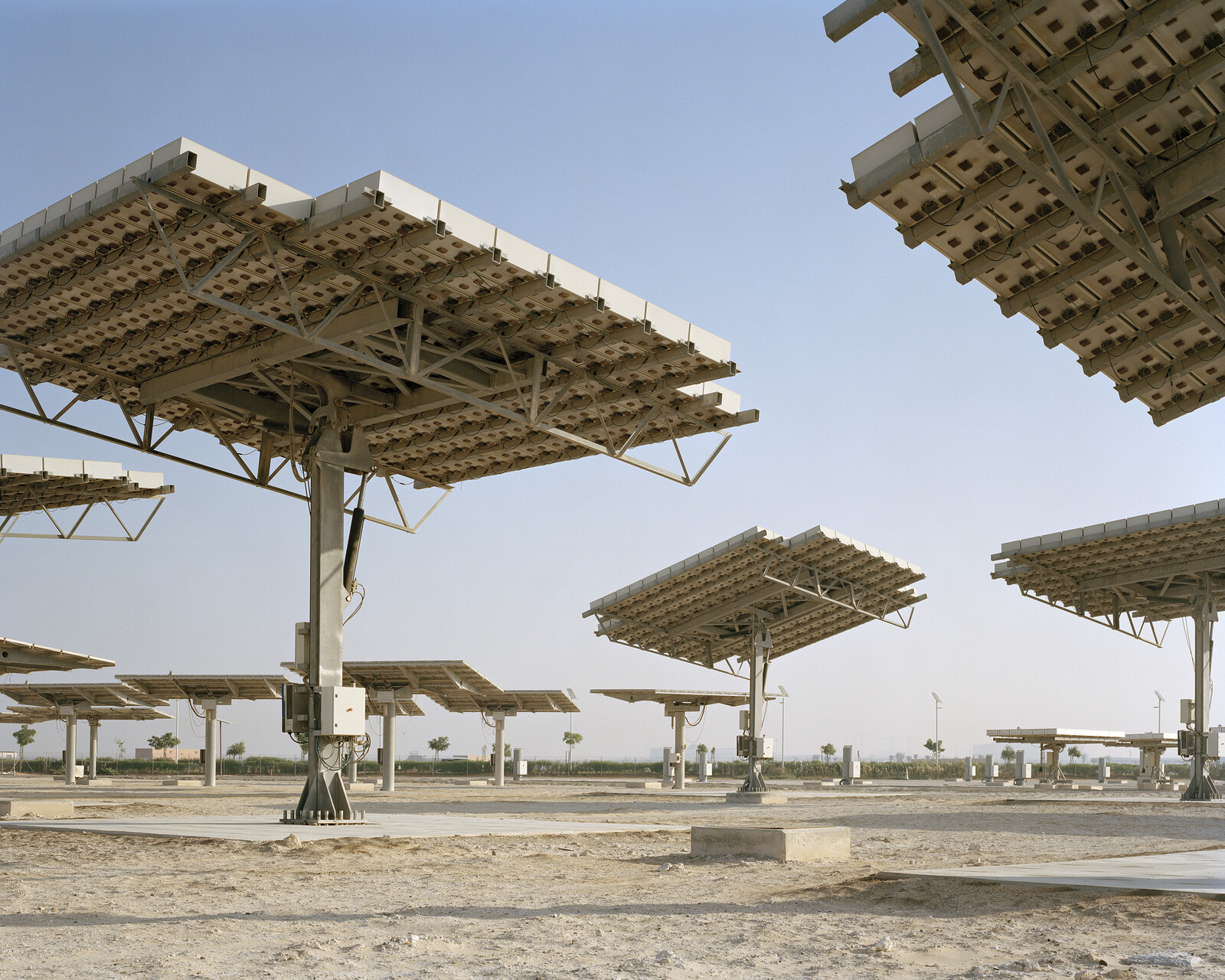For the last two years, a battle has gripped the southern rim of Atlanta. The combined forces of the City of Atlanta and Dekalb County governments, private investment firms, corporate power players, the Atlanta Police Foundation, and film and television production studio Blackhall Studios have worked to destroy close to 400 acres of the city’s largest forest in order to build a $90-million, eighty-five-acre police training compound and a massive $400-million, forty-acre movie studio complex. Only a valiant effort of forest defenders has held them off. Residents have marched, organized petitions, filed lawsuits, and sponsored teach-ins.1 Muskogee (Creek) people from Georgia, Oklahoma, and Alabama have gathered for a rematriation summit and stomp dance ceremony on their historic territory.2 Raves and music festivals have filled the woods with crowds and the echoes of rap, folk, and techno past sunrise.3 Construction equipment has been sabotaged, incursions into the forest pushed back, demonstrations held at the homes of the heads of subcontracted engineering firms, and memes circulated widely online.4 Around the city, “Defend the Atlanta Forest” signs are displayed in yards, and in the heart of the forest, wooden treehouses cling sturdily to mature tree limbs and trunks. Below, a village threads through the woods: tents, tarped dwelling areas, and outdoor kitchens. Huge banners suspended between towering trees sway in the wind, welcoming supporters to the forest and demarcating the line that has been drawn around it: “No Cop City, No Hollywood Dystopia.”
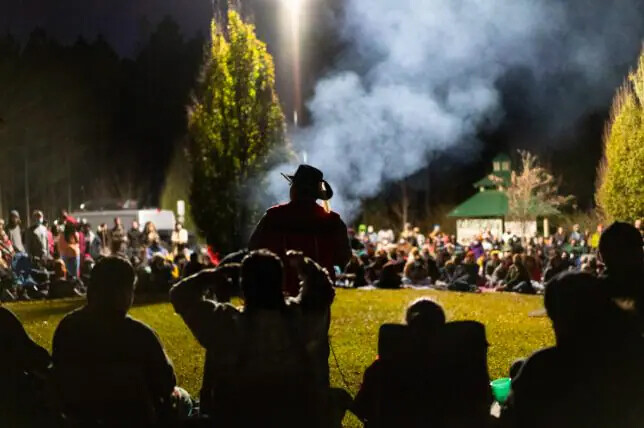

In November, 2021, members of the Muscogee (Creek) Tribe currently living in the Helvpe Ceremonial Grounds in Oklahoma traveled to their historic territory in Atlanta’s South River Forest. The stomp dance and cultural sharing events they held in Intrenchment Creek Park were attended by hundreds of people. Photo copyright Jesse Pratt López, approved by Mekko Chebon Kernell on behalf of the Muscogee (Creek) community / The Mainline.
Much more than a local conflict or environmental defense activism, the battle for the South River Forest brings to the fore critical questions of urban life in the age of climate change. On the one hand, the situation in the forest illuminates emergent mutations of urban space, process, and government produced by capitalist urbanization and control in the shifting social-ecological contexts of the twenty-first century. On the other hand, it points to significant transformations in the strategies and struggles through which humans, as world creators and dwellers, fight for life on a planet being pushed into the abyss. As such, the conflict in the Atlanta Forest is a struggle over the future of urban life in the Anthropocene.
§1 The South River Forest is a central site of the tipping point between two possible futures prescribed for Atlanta from the perspective of climate governance: the city will be either a “climate refuge” or a climate no-go zone.
Roughly three and a half hours from the Atlantic coast and nestled in Georgia’s piedmont region, Atlanta is the nineth largest metropolitan area in America. It is also one of the fastest growing. Despite this, 47.9% of Atlanta’s land is covered in tree canopy—the highest of any city the country. This lush, interconnected network of mature pines, oaks, magnolias, and other trees together gives Atlanta its nickname the “city in a forest.”5 Alongside making it more verdant and livable than some other urbanized areas and providing habitat for pollinators, birds, and a wide array of other wildlife, Atlanta’s approximately 3.7 millions trees generate increasingly critical ecosystem services in an era of climate chaos.6 With global warming, Atlanta faces increasingly frequent and intense rainfall, catastrophic flooding, and hotter, longer-lasting heat waves, as well as potentially lethal wet bulb temperatures.7 According to Climate Central data, average summer temperatures in Atlanta have increased by 2.9°F over the last 50 years.8 In the summer of 2022, as part of a triple-digit heat wave blanketing the American Midwest and South that led the National Weather Service to advise a third of America to stay indoors, several Georgia cities experienced temperatures above 100°F, and Atlanta tied a fifty-year old June heat record of 98°F. The previous week it broke a heat record by reaching 99°F.9
The proposed razing of Atlanta’s tree canopy is directly connected with this epochal crisis. As local organizations such as the South Atlanta Watershed Alliance repeatedly point out, the demolition of the South River Forest will directly decrease the city’s natural ability to field extreme heat and flood events by shifting greater burden onto already-stressed grey infrastructure and eliminating the natural shade and cooling provided by urban tree canopy.10 Furthermore, forests sequester CO₂, and Atlanta’s urban forests’ annual gross sequestration rate has been estimated at 42,000-45,000 tons of carbon per year, the highest among cities with significant tree cover in America.11 Urban governments know well the importance of urban ecosystems services and climate futures, which is why the City of Atlanta’s own 2017 Atlanta City Design: Aspiring to the Beloved City urban plan envisioned the forested area currently slated for construction as part of an enormous 1,200-acre urban greenspace.12
These global warming trajectories intersect with other forecasts for Atlanta, in particular intimations that it will be a “climate refuge.” Used with increasing frequency over the past several years, the terms “climate haven” or “climate refuge” refer to areas projected to receive significant chunks of the tens of millions of climate refugees and migrants as they flee wildfires, natural disasters, or coastal flooding along the planet’s densely developed coastlines.13 Once discussed as a far-off future matter, in recent years media, planners, and politicians have begun advocating immediate and proactive relocation. During the pandemic, as extreme weather intensified and became more frequent across the country, planning and media discourse began suggesting that we have reached the “limits” of urban resilience—the dominant discourse and practice of climate adaptation in cities since at least 2010—advocating instead a post-resilience form of adaptation focused on defunding and disinvesting from flood- and storm-prone cities.14
This emergent discourse is exemplified by a recent Washington Post opinion piece by the scenario strategy advisor Parag Khanna.15 Published in November 2021 after historic flooding in the Pacific Northwest and British Columbia caused by an “atmospheric river” that poured multiple inches of rain in hours, Khanna’s piece argues that while wealthy American cities like Boston, New York, Los Angeles, or San Francisco can afford to build resilience to rising seas, hurricanes, and wildfires, others cannot. Citing the growing number of hurricanes slamming the Louisiana Gulf Coast in recent years and the economic cost of rebuilding infrastructures like power lines that will only be knocked out by subsequent storms, Khanna argues that New Orleans “is going the way of Venice,” and the US government “must realistically assess which geographies are becoming unlivable and which are well suited to larger population settlement. It should then offer incentives for migration toward the latter and away from the former—and direct infrastructure spending accordingly… Property developers should lure displaced Americans to gentrify the Rust Belt along the Great Lakes. The people of New Orleans should be given one-way tickets to Detroit, where they can contribute to the city’s nascent postindustrial revival.”
Khanna’s vision of defunding and disinvesting from flood- and storm-prone cities, and attendant climate refuge gentrification elsewhere, is currently just a proposal. Still, it is part of a broader climate adaptation narrative that has been gaining traction.16 This discourse is focused not on securing existing spaces but instead declaring their obsolescence, while simultaneously identifying specific cities and regions as climate refuges. The mayor of Buffalo, New York set the first explicit precedent for this in 2019 when he designated his city a Climate Refuge City, in hopes of attracting new residents and economic investment.17 Later that year, the New York Times proposed Duluth, Minnesota as a critical climate refuge.18 For Rust Belt cities that have sustained economic, population, and job losses since the 1970s, taking on the mantle of a climate refuge is increasingly seen as an attractive branding angle. Access to increasingly scarce resources is often seen as a key qualifier for climate refuge status (the Great Lakes hold 20% of the world’s fresh surface water). Even hot, crowded, and water-poor Atlanta is projected to be the destination of at least 250,000 climate migrants as coastal cities like Savannah, Charleston, or Miami become increasingly inundated.19 This is likely a conservative estimate however: in the immediate aftermath of Hurricane Katrina in 2005, more than 100,000 people evacuated to Atlanta in a matter of days.20
The destruction of the South River Forest will undermine the city’s ability to be any kind of climate sanctuary or refuge. After all, even though Atlanta is a “city in a forest,” it is now the city in the United States that is losing tree cover the fastest.21 Rather than the verdant green canopy and flowing fresh water of climate utopian city visions, this is a future Atlanta closer to Bladerunner 2049’s Los Angeles: crowded, polluted, and denuded of life, with elites ensconced in the city’s John Portman-designed concrete and glass compounds while swelling surplus populations are crowded into dilapidated apartments, surveilled and held in check by state-of-the-art militarized police.
§2 The proposed construction of Cop City is one instance of a broader global tendency of governments’ use of cities as laboratories for experiments in social control and profit extraction in the era of climate chaos and social upheaval, dynamics of which were exacerbated by the pandemic.
On the heels of the George Floyd Rebellion in 2020, the Atlanta Police Foundation proposed building a $90-million, eighty-five-acre police training complex. Slated for the site of a former prison farm, “Cop City” plans include a mock city for police training simulations, replete with gas stations, banks, apartment complexes, nightclubs, and splash pads, as well as burn and explosives test sites, shooting ranges, and a helicopter landing pad.22 The police training compound will be two times larger than that of the New York Police Department and three times the size of the Los Angeles Police Department’s, the two largest police departments in the country. Originally named the Atlanta Institute for Social Justice and Public Safety Training, “Cop City” is touted as a way of rebuilding the Atlanta Police Department’s morale and a method of bridging the gap between the police department and “the community,” with weekly farmers’ market and community garden plots.
After the police murder of Floyd in the summer of 2020, an impassioned uprising overwhelmed cities across America and prompted urban elites to search for new social management strategies. This was especially the case across metro Atlanta where massive crowds took over streets and parks, disregarding curfew orders to march together, burn police cars, and loot stores. Unable to contain the situation, the governor declared a state of emergency in late May for every county in Georgia, deploying thousands of National Guard troops to parks and malls across Atlanta. The uprising shattered the peace of the “Atlanta Way,” a longstanding political alliance between black and white business classes.23 This power sharing arrangement and agreement on moderate, incremental reform rather than direct confrontation is widely celebrated as the reason why the city remained peaceful in the aftermath of Martin Luther King Jr.’s assassination. In 2020s America, this strategy is less effective as dividing lines are more unclear; instead of simple black and white, there is a multiracial bourgeois governing class alliance of economic and cultural elites, and America’s motley multi-racial urban and suburban proletariat. This striation was visible in the 2020 Floyd uprising in Atlanta, when then-mayor Keisha Lance Bottoms and Killer Mike—a major property owner in the city’s West side—issued “go home” appeals during the uprising.24
Amidst such change, real estate interests and business coalitions who back the Atlanta Police Foundation sought revised approaches to ensure that such widespread—and frequently multi-racial and multi-generational—urban uprisings would never occur again. Academic, governmental, and military strategists widely agree that volatile urban spaces are the key conflict environments in which the twenty-first-century’s political and environmental upheavals will play out and against which existing counterinsurgency methods, devised in past environments and conditions, are woefully insufficient. As a 2016 counterinsurgency training video produced by the US Army and screened at the Pentagon’s Joint Special Operations University warned, “our current and past strategies can no longer hold. We are facing environments that the masters of war never foresaw. We are facing a threat that requires us to redefine [military] doctrine and the [army] in radically different ways. The threat is clear. Our direction remains to be defined.”25
Increasingly, governments and police are now using cities as laboratories for experimenting with new modes of government and control. Some of this involves design-based efforts to construct infrastructures able to fortify cities against climate change and disaster. From New York to Miami, Lagos to Kyoto, the supposed imperative of resilience building has formed the substrate of a profound transformation of urban planning and government based on a rejection of modernist city/nature binaries and attempted interlinking of living beings, natural processes, and technological systems via sensing nodes, disaster management infrastructure, and human communities. Urban resilience in this way flanks and creates important discursive and material conditions in which a truly cybernetic world can freely unfold. But along with managing the impact of hurricanes and floods on markets and infrastructure, building a “resilient” urban space is also a matter of developing new modes of counterinsurgency to administer social upheaval and maintain order, such as those that will be trialed in the Cop City facility. As former Atlanta mayor Keisha Lance Bottoms put it, the goal of Cop City is to enable “twenty-first-century training” for “twenty-first-century policing.”26 Thus its opposition, often summed up in the slogan “Stop Cop City,” takes on historical and global significance.
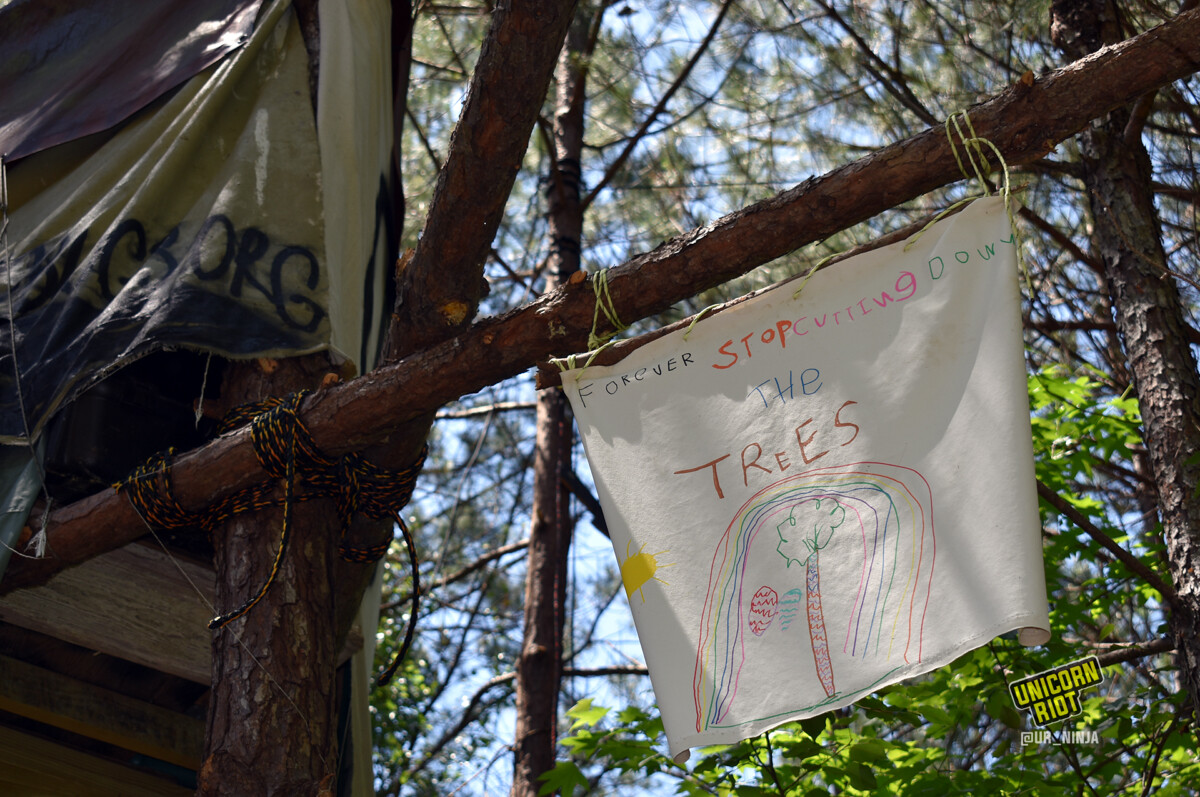

“Forever stop cutting down the trees,” a banner made by children suspended from a treehouse in Atlanta’s South River Forest. Copyright Ryan Fatica. Source: Unicorn Riot.
§3 The proposed construction of Blackhall Studio is a step in the emergent hyper-striated Anthropocene world, in which the economic success of global investment firms functions as the organizing principle of policing, the urban environment, the nonhuman elements of the world, human populations, and possible human ways of life.
Immediately east of the proposed site for Cop City and on top of even more of the South River Forest, Blackhall Studios and CEO Ryan Millsap plan to expand the footprint of Atlanta’s film industry. While the police training compound needs to be read in light of urban counterinsurgency experiments for a post-George Floyd, climate chaos world, Blackhall Studio’s plans for the forest need to be understood in the post-pandemic context of real estate and finance-driven “hostile urban takeovers.”27 According to David Madden, Covid-19 has “inaugurated a new phase of urban political-economic recomposition, realignment, and restructuring.”28 Driven by a range of political projects being legitimated in the name of pandemic response, this emergent paradigm of “covid-capitalist urbanization,” as he names it, is characterized by the escalation of pre-existing forms of rentierism, the remodulation of workplace conditions, and the intensification of the relationship between urban government, tech companies, and algorithms.29 One can think here of how the pandemic has served as an opportunity for live trials of surveillance and tracking technologies in the form of selfies, robotics, and AI, as well as “pandemic smart city” tech such as contact tracing apps and drones, or social contact monitoring and vaccination pass systems.30 But the pandemic has also seen private equity firms, real estate, and venture capitalists seize control of urban futures, launching new forms of accumulation by dispossession that are fueling a real estate market frenzy and massive housing shortages.
Founded in 2017 by Ryan Millsap, CEO of Irinda Capital Management (ICM)— owner of tens of thousands of apartments across the Sunbelt—Blackhall played host to a slew of movies like Venom (2018), Godzilla: King of Monsters (2019), and Jumanji: The Next Level (2019) as well as straight-to-streaming shows like Lovecraft Country (2020). Eyeing expansion, Blackhall originally snapped up properties in the largely black, working-class Gresham Park neighborhood around the South River Forest, and in a February 2021 deal with the Dekalb County government, Blackhall managed to “swap” fifty-three non-contiguous acres in Gresham Park for forty acres of Intrenchment Creek Park. In April 2021, Millsap sold Blackhall to Commonwealth Asset Management for $120 million while retaining “a substantial minority interest.”31 Since then, Blackhall has partnered with private equity firm Silver Lake, which infused the project with $500 million, renamed Shadowbox, and announced a $1.5 billion, global expansion plan.32 While Millsap sold controlling interest in Blackhall, he retained legal control of the forty acres of Intrenchment Creek Park slated for clearcutting. To what end is not currently clear, but he has announced plans for a new streaming platform, Blackhall Americana.
The rapid proliferation of the content industry over the last two years is unsurprising. During the pandemic, streaming services reached a high of some 1.1 billion subscribers, or roughly one in eight people on the planet.33 Demand has only increased, and generationally speaking, it is Millennials and Gen Z who consume the most, whether it’s streaming services like Netflix (150 million subscribers in the US), Amazon Prime, and Disney+, or platforms like TikTok, which has roughly 100 million monthly users in the US. The space of content is rapidly expanding, and Facebook’s conversion into Meta is a sign of things to come. Shadowbox’s most recent investor, Silver Lake, is a largely technology-centered investment firm, which in April 2022 invested $150 million into Genies, an avatar ecosystem for the metaverse promising “Your own mini world. Oh, and you own it all.”34
In 2016, a Danish politician writing for the World Economic Forum penned an essay titled, “Welcome to 2030. I own nothing, have no privacy, and life has never been better.” The essay predicted a shift towards a sort of AI-run Nordic luxury socialism, but it recently went viral on right-wing Twitter due to its provocative title and in response to revelations that private equity firms like Blackstone are transforming America into a nation of renters.35 Amidst a decline in new housing construction, private equity firms are snapping up single-family homes and converting them to rentals. According to geographer Desiree Fields, these firms own a growing portion of the single-family home rental market, with the four largest—Invitation Homes, American Homes 4 Rent, Tricon Residential, and Front Yard Residential—owning approximately 182,000 units nationwide. Significantly, Atlanta is the epicenter of this change, with those four firms owning 27,000 single-family homes in the metro area.36
The reach of private equity firms extends beyond the single-family home renter market. Invitation Homes is actually a creation of Blackstone, which recently purchased Preferred Apartment Communities for $6-billion and its 12,000 multi-family housing units in cities like Atlanta, Nashville, and Tampa. In 2021, half of Blackstone’s more than $12-billion profits were from real estate alone.37 This cash grab extends into Atlanta’s low-income apartment complexes. With lax laws concerning’s renter’s rights and decrepit living standards abound, according to the Atlanta-Journal Constitution: “At least three-fourths of the region’s most dangerous apartments … belong to private equity firms or other absentee investors under whom crime and squalor are not so much bad fortune as collateral damage from a widely followed business model.”38 Mold, broken appliances, and violence related to the city’s drug trade combine to make an unlivable situation for many tenants, yet they are trapped paying higher rents to massive predatory institutions dedicated to scraping ever more money off the back of the average American.
The point here is not to remind that there is in fact a capitalist class, but rather to reveal the linkages between their actions and to understand the future they have in store for the rest of us if they were to succeed. At the end of the day, organizations like Shadowbox and the private equity firms it represents don’t want to just make movies or streaming shows; they want to reshape the world in a darker, more synthetic way. Their designs fuse endless content with the creation of urban and suburban fiefdoms. In other words, they would destroy a forest to make a movie about a jungle that you stream while you live in the pod and eat the bugs. They’d play host to films that cast black actors and tout environmental themes while contributing to environmental racism and increasing gentrification and displacement. They’d make Atlanta hotter and less alive, leaving us further from a future we can survive in or even remotely influence.
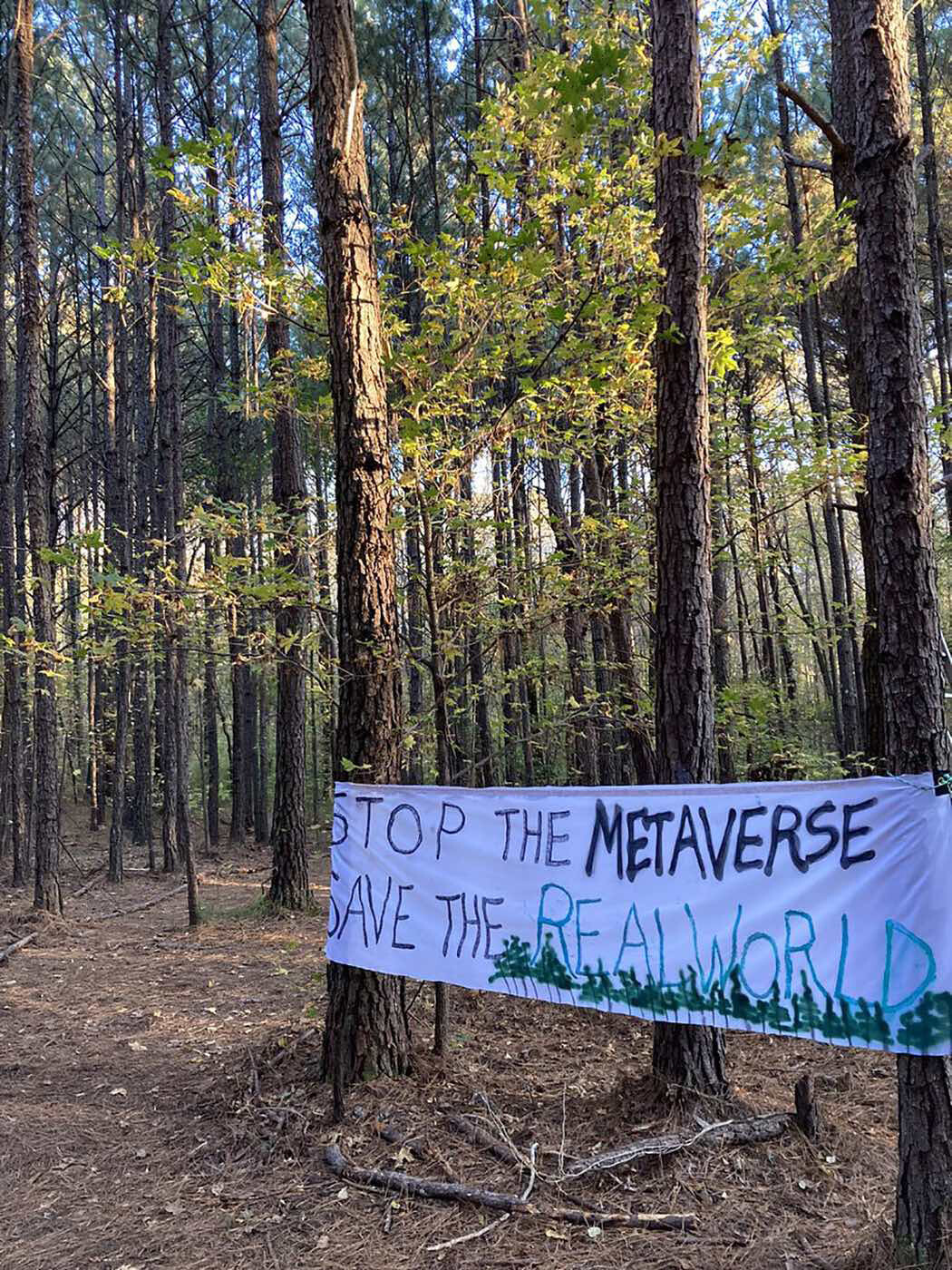

“Stop the metaverse, save the real world,” a banner displayed in Atlanta’s South River Forest. Photo: Defend the Atlanta Forest.
§4. The fight for the forest is a hubristic, innovative fight for life in and against emergent Anthropocene urban dystopias.
On a weekday morning this past June, a caravan of cars, trucks, and dirt bikes clogged the road along the perimeter of the South River Forest. They delivered bouquets of flowers and signs of support to the tree sitters who, inhabiting makeshift houses high in the trees, have put their lives on the line to defend the forest.39 Families, zoomers, and dirt bikers honked their horns and blasted radios to show their appreciation for the tree sitters and the forest itself.
The plan to bulldoze a maturing urban forest to build urban counterinsurgency training compounds and produce more streaming content clearly encapsulates the dystopian—and careless—nature of contemporary neoliberal regimes and the increasingly apocalyptic trajectory they are on. We are entering crucial decades of climate chaos in the twenty-first century. Heat waves come like clockwork; in the American west, water reserves are at historic lows; panthers, gorillas, songbirds, bees, butterflies, and frogs are on the verge of extinction; food and gas shortages and material price spikes have already triggered demonstrations and riots in response. Meanwhile the dominant solutions to the climate crisis are to either deny its existence outright or enforce austerity measures on the general population.
In contrast, the defense of the South River Forest illuminates a possible path forward, one that is nascent but nevertheless vital in the present: the fight for life. Everyone defending Atlanta’s South River Forest is acting for both themselves and those who will inherit the land after them. It’s become an existential and also commonsense matter of whether there will be anything but avatars and heat waves for those who come next. For many people, the only human response to watching the video of George Floyd’s murder was to open the door and go outside in the midst of a pandemic and stay-at-home orders to join millions of others in the street. Today, for many, the only human response to attempts to bulldoze the South River Forest and build a landscape of police training and Hollywood film compounds has been to get up and go to the woods.
We live in a time of rapid change and cascading crisis. It’s imperative that we are able to stand back from the noise of each moment and see the present “poly-” or “perma-” crisis as a time of epochal and governmental remodulation.40 We should be attentive to these changes in narrative and material reality, and be able to understand them when they are incipient rather than already full-blown. Too often, like the Owl of Minerva spreading its wings only with the falling of dusk, we only see the walls that have been erected around us once they’re already cemented in stone. Perpetually late to the game, power has moved on. The conflict in the Atlanta Forest highlights some of these changes: urban global warming, refuge cities, cities as labs where control and extraction are being recalibrated. But it also points to the need for people (whoever they are, wherever they are) to be as innovative and ready to use the present as an opportunity to experiment freely with new forms of thought, strategy, and life. “Stop the Metaverse, Save the Real World”—inscribed on a banner tied between two loblolly pines in the South River Forest— are the philosophical and political stakes of our time.
Tyler Estep, “DeKalb judge allows lawsuit over film studio land swap to proceed,” The Atlanta Journal-Constitution, March 21, 2022, ➝.
Mark Auslander, “Songs of the Forest: A ‘Re-matriation’ Gathering in Weelaunee (South River) Forest,” April 26, 2022, ➝.
The Raury Thing (LIVE @ The Woods), July 23, 2022, ➝.
Ryan Fatica, “Atlanta Fights to Save its Forest,” Unicorn Riot, May 14, 2022, ➝; Charles Bethea, “The New Fight Over an Old Forest in Atlanta,” The New Yorker, August 3, 2022, ➝; Ella Fassler, “Activists Are Occupying the Woods of Atlanta to Block a New Police Facility,” Vice Motherboard, February 17, 2022, ➝.
Eric Kuehler, “Putting Numbers to Stormwater and Other Benefits of Atlanta’s Urban Forest,” US Forest Service, Urban Forestry South, February 4, 2020, ➝
USGCRP, “Fourth National Climate Assessment: Chapter 19: Southeast,” NCA4, ➝.
Emily Jones and Molly Samuel, “The Heat Effect: How the Climate is Changing Georgia,” WABE, June 22, 2022, ➝.
Jeremy Fuster, “Atlanta Studio Sparks Protests for Plan to Clearcut 200-Acre Forest for More Soundstages,” Wrap Pro, July 7, 2021, ➝.
David J. Nowak and Daniel E. Crane, “Carbon storage and sequestration by urban trees in the USA,” Environmental Pollution 116, no. 3 (2002): 381–389; Ian D. Yesilonis and Richard V. Pouyat, “Carbon stocks in urban forest remnants: Atlanta and Baltimore as case studies.” In: R. Lal and B. Augustin., eds. Carbon sequestration in urban ecosystems (Dordrecht: Springer, 2012): 103–120.
City of Atlanta Department of City Planning (2017) The Atlanta City Design: Aspiring to the Beloved Community, 330-337, ➝.
Mathew E. Hauer, “Migration induced by sea-level rise could reshape the US population landscape,” Nature Climate Change 7 (2017): 321–325.
Robinson Meyer, “We’re Hitting the Limits of Hurricane Preparedness,” The Atlantic, August 29, 2021, ➝.
Parag Khanna has been named as one of Esquire’s “75 Most Influential People of the 21st Century,” and has worked for the World Economic Forum, the Brookings Institution, and the US Special Operations Forces in Iraq and Afghanistan. Parag Khanna, “Climate migration is here. The U.S. must invest accordingly,” Washington Post, November 17, 2021, ➝.
See, e.g., Jeff D. Opdyke, “Global Warming: These Northern Cities Offer Attractive Refuge,” Guaranteed Rate, ➝.
“Buffalo Mayor Byron Brown delivers 2019 State of the City Address,” News 4 WIVB Buffalo, February 15, 2019, ➝.
Kendra Pierre-Louis, “Want to Escape Global Warming? These Cities Promise Cool Relief,” New York Times, April 15, 2019, ➝.
Craig Schneider and Mark Davis, “Katrina Evacuees Rebuild, Remember,” The Atlanta Journal-Constitution, August 30, 2015, ➝.
DJ Nowak and E. Greenfield, “Declining urban and community tree cover in the United States,” Urban Forestry & Urban Greening 32 (2018): 32–55.
On the Atlanta Way and the George Floyd Uprising in Atlanta, see “The City in the Forest: Reinventing Resistance for an Age of Climate Crisis and Police Militarization,” Crimethinc, April 4, 2022, ➝; see also Ernie Suggs and Rosalind Bentley, “‘Atlanta Way’ challenged after violent night of protests,” The Atlanta Journal-Constitution, May 30, 2020, ➝.
Shemon Salam and Arturo Castillon, The Revolutionary Meaning of the George Floyd Uprising (Québec: Daraja Press, 2021); Raisa Habersham, “Atlanta mayor urges violent protesters: ‘Go home’,” The Atlanta Journal-Constitution, May 29, 2020, ➝.
US Army, “Megacities: Urban Future, the Emerging Complexity,” The Intercept, October 13, 2016, ➝.
Andrew Boryga, “Atlanta’s ‘Cop City’ Will Become a Reality, Despite Pushback,” The Daily Beast, September 9, 2021, ➝.
Stephanie Wakefield, Sarah Molinari, and Kevin Grove, “Crypto-Urban Statecraft: Post-Pandemic Urban Governance Experiments in Miami,” Urban Geography (2022).
David Madden, “The Urban Process Under Covid Capitalism,” City 24, no. 5–6 (2020): 677.
Ibid., 678.
Ayona Datta, “Self(Ie)-Governance: Technologies of Intimate Surveillance in India under COVID-19,” Dialogues in Human Geography 10, no. 2 (2020): 234–237; Bei Chen, Simon Marvin, and Aidan While, “Containing COVID-19 in China: AI and the Robotic Restructuring of Future Cities,” Dialogues in Human Geography 10, no. 2 (2020): 238–421; Ola Söderström, “The Three Modes of Existence of the Pandemic Smart City,” Urban Geography 42, no. 3 (2021): 399-407.
“Ryan Millsap sells Blackhall Studios, plans new ventures,” Saporta Report, April 28, 2021, ➝.
Gene Maddaus, “Blackhall Studios Announces New Name and New $500 million Investor,” Variety, June 14, 2022, ➝.
➝.
➝.
Ida Auken’s essay has since been removed from the WEF’s site, but it was also published here: ➝.
Desiree Fields, “Corporate Landlords and Market Power: What Does the Single-family Rental Boom Mean for our Housing Future,” Presentation, Atlanta Regional Housing Forum, June 1, 2022, ➝.
Maureen Farrell, “Blackstone expands further into rental housing in the United States,” New York Times, February 16, 2022, ➝.
Alan Judd and Willoughby Mariano, “At violent apartment complexes, business model thrives on housing shortage, government inaction,” The Atlanta Journal-Constitution, June 9, 2022, ➝.
Atlanta Community Press Collective (@atlanta_press), “The rally to #StopCopCity today was a glowing success. Nearly 50 people gathered with signs and formed an impromptu car caravan to deliver flowers and signs of support to tree sitters.” Twitter post, June 7, 2022, ➝; La’Tasha Givens, “’It’s not for our community,’” 11 Alive News, June 7, 2022, ➝.
Horizons is a collaboration between e-flux Architecture and the International Architecture Biennale Rotterdam.
